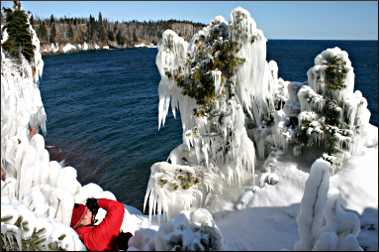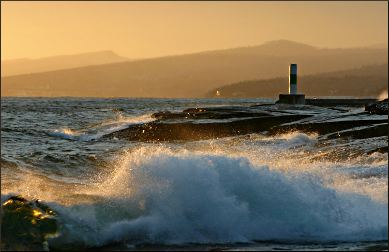Capturing winter's beauty
In photography workshops, learn how to translate snow and ice into stunning images.

© Beth Gauper
Nothing is more photogenic than winter.
You've got icicles dripping off cliffs, trees covered with hoarfrost and pancake ice floating on harbors. But how do you capture all that?
As anyone who's tried winter photography knows, it's no snap.
The eye sees white snow sparkling on an undulating landscape. But in your photograph, the hills are flat, shadows have appeared out of nowhere and the snow is as gray as old underwear.
It could be time to take a photography workshop.
"Interest in workshops is skyrocketing," says photographer/instructor Bryan Hansel of Grand Marais, Minn. "With a digital camera, you can get a good-quality image fairly easily, so when you come to a workshop, it's pretty much guaranteed you'll go home with good images."
In winter, it's all about the light. Every instructor will make you get up before dawn to catch the first rays of sunlight, which bathe all that snow and ice in reflected color.
"Winter is my favorite time to shoot," Hansel says. "It's always brighter and more vibrant, with better color."
"It's a quality of light you don't see any other time of year," says John Gregor of ColdSnap Photography in Two Harbors, Minn. "In winter, it bounces around more."
Gregor and nature photographer Randy Hagar teach weekend workshops, and one year, I signed up for "Winter Splendor: A Photographic Retreat" at a retreat center in the St. Croix River Valley.
The first thing our instructors did was tell us not to worry about having fancy equipment, because we already had what we needed to take good photos.
"All this technical stuff is just a means to an end," Gregor said. "Your objective is to see the world in a different way, a complex way. You can't just go out and say, 'I'm going to get this picture.' You have to let the preconceptions go, be in the moment so you can see the images and capture those."
After a discussion of techniques — to counteract the camera's tendency to see snow as gray, he said, open the lens aperture an extra two stops — we went hunting.

© John Gregor
Some of us walked down to the snowy surface of a lake, shooting stumps and footprints and an old fishing boat. Some of us prowled around buildings, trying to find art in the snow-topped curves of patio furniture.
Hagar used a macro lens to shoot a bit of red fungus on a wood bench, creating a beautiful image that had the rest of us sighing with envy.
The next day, we got up before dawn and set up our tripods near an old farmstead, waiting. A band of pink as rosy as raspberry sherbet appeared on the horizon, and we shot away at a field filled with hay bales.
My fingers were freezing, and I was walking away when I glimpsed a photogenic cluster of seed pods in a halo of pink. But as I was focusing my zoom lens, the rosy light faded into gray.
In photography, timing is everything.
After lunch, Gregor reviewed our photos. Most of us had compositions ruined by shadows from the harsh sun.
As we'd focused on our main subjects, they'd escaped our notice. So had the warning on page 16 of the course manual:
"EVERYTHING THAT IS IN THE VIEWFINDER AT THE MOMENT THE IMAGE IS MADE WILL BE RECORDED ON THE FILM."
"What you see is not what you get," Hagar noted.
After 48 hours in the near-constant company of professionals, we'd learned about filters and gray cards, bracketing and the rule of thirds. We'd learned how to see what was in our viewfinder.
We knew we still would make many mistakes. But, as Gregor had told us, we also knew we had what it takes — at least, some of the time.
A few winter-photography tips
On a really cold day, keep your camera inside your jacket, next to your skin. It prolongs battery life and possibly your camera (once my shutter froze — permanently — in a minus 70-degree windchill on Minnesota's North Shore).
To correct the camera's tendency to underexpose a large expanse of snow and turn it gray, overexpose by opening the lens one or two stops.

© Beth Gauper
For the best light, shoot at sunrise, when colors are most luminous, and just before sunset, when the sun's rays skim across the landscape at a low angle.
Try not to shoot at high noon on a sunny day, when shadows are bouncing all over the place. If you have to shoot a high-contrast landscape, frame it as tightly as possible. Or shoot wide, with a person in a colorful jacket popping out amid an expanse of white, brown and gray.
Is the sky gray and washed out? Just try to keep it out of your shot.
Add interest to a monochromatic scene by lying on your back and shooting up with a wide-angle lens.
In this video from Duluth Public TV, shot on Artists Point in Grand Marais, Bryan Hansel offers tips that include "Eliminate everything that doesn't make a strong graphical element."
Duluth photographer Dennis O'Hara offers tips in Lake Superior magazine on shooting the northern lights — as well as the tricky part, finding them.
He also offers seven winter photography tips on how to take care of your camera — and yourself — while shooting in cold weather.
Photography workshops
Bryan Hansel Photography, Grand Marais, Minn. Hansel offers workshops year-round, such as the three-day Lake Superior Winter Photography Workshops and "Capturing the Frozen Shore: Photographing Lake Superior in Winter".
In late fall, he teaches a popular Gales of November workshop. He also teaches one on one.
Layne Kennedy in Minneapolis. He teaches some workshops, such as one on a dog-sledding trip with Ely's Wintergreen Lodge.
Cold Snap Photography in Two Harbors, Minn. John Gregor teaches workshops in Minnesota and farther afield.
North House Folk School, Grand Marais, Minn. This harborside school offers workshops year-round. Instructors include Bryan Hansel, Paul Sundberg and Layne Kennedy.
For more about the area, see Artistic Grand Marais.
For more on the unusually large number of fine photographers on Minnesota's North Shore, see Following the photographers.
Madeline Island School of the Arts in La Pointe, Wis. This island school, across from Bayfield, offers many weeklong photography classes in summer and fall.
For more about the island, see Madeline's magnetism.
The Clearing, Ellison Bay, Wis. This folk school in Door County offers a weeklong photography workshop in spring and in fall.
For more, see Classroom in the Clearing.
Many other schools in vacation areas offer weekend photography workshops. For a list, see Schools of know-how.